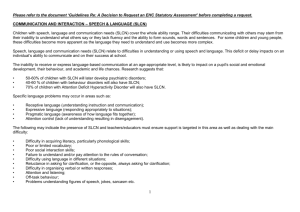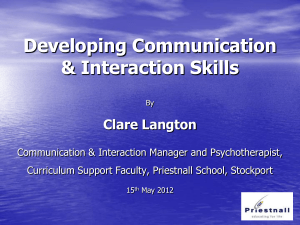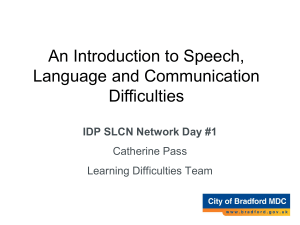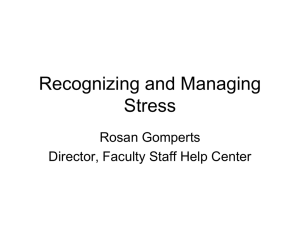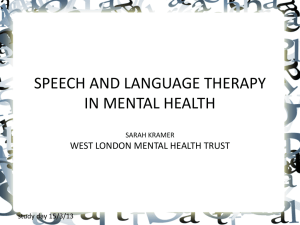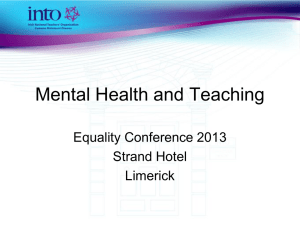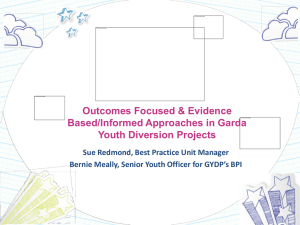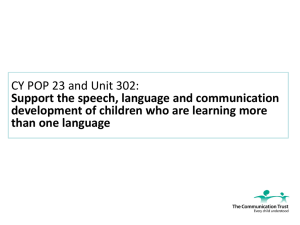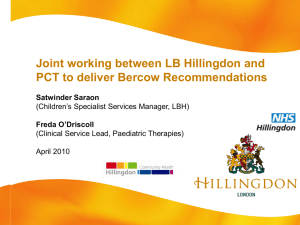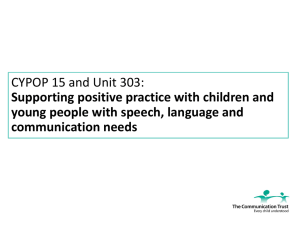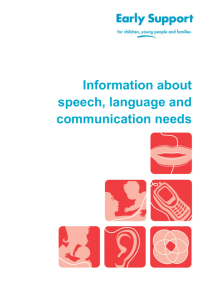Making the Links Language and Behaviour
advertisement
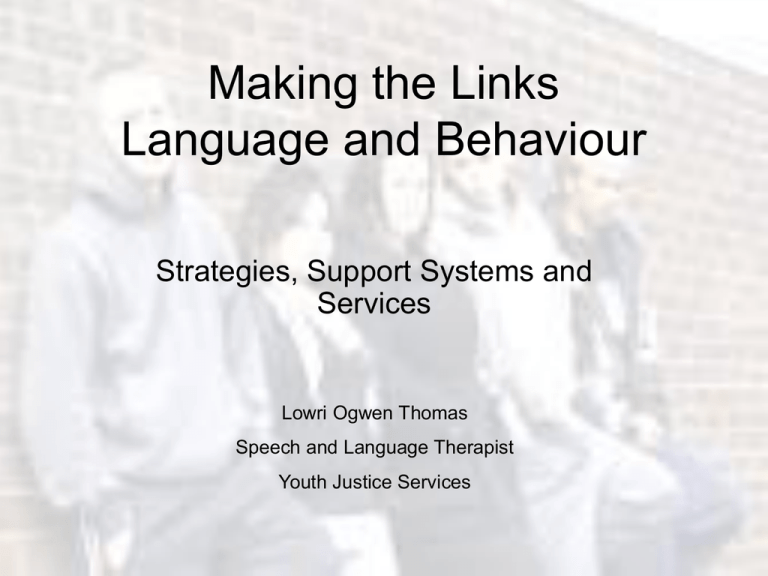
Making the Links Language and Behaviour Strategies, Support Systems and Services Lowri Ogwen Thomas Speech and Language Therapist Youth Justice Services Introduction Session Aims o Background Information o Prevalence of Speech, Language and Communication Difficulties (SLCD) within the Youth Justice Population o Aims of a Speech and Language Therapy (SLT) Services within Youth Justice Services (YJS) o Strategies to support young people identified with Speech, Language and Communication Needs (SLCN) o Support Services that need to be in place for children and young people o Question and (Possible) Answer!!! Background Speech, Language and Communication Needs (SLCN) o The ability to speak and be understood, to listen and understand are the vital skills needed to develop and enable life skills (I CAN, 2007). o These skills are the building blocks that help us to define who we are, how we make friends, how we succeed at school and beyond. o It is widely recognised that many children find developing these skills difficult. It is estimated that there are 3 children in every classroom who find speech and language difficult, and this can make their life very difficult. o Poor language skills affects a child’s confidence and their ability to form relationships, friendships and relate to other people. o Without language how would you express an opinion, have a joke with a friend or tell someone what’s worrying you? How would you connect? It would be like trying to find your way without a map. It would be easy to get lost (I CAN, 2007). Speech, Language and Communication Needs (SLCN) Continued… o This is the challenge that many young people are facing today. They don’t have the language to express themselves, solve problems, support each other, or learn. o Without this ‘map’, children are at vulnerable to ‘get lost’ or to follow the ‘wrong path’ down ASBO Street, left passed NEET Avenue (Not in Employment or Education) straight through PRU Crescent (Pupil Referral Unit) to HMP Central (Her Majesty's Prison) via the YOI (Young Offenders Institution). o It is estimated that between 60%-90% of vulnerable young people have undetected communication difficulties. o How can these young people progress without language skills? (I CAN, 2007) The Research Language and Communication Difficulties in Juvenile Offenders o It is recognised that young people who engage in criminal activity typically have a history characterised by poor school achievement, learning difficulties, and truancy. (Bryan et al. 2007) o Communication difficulties are often found to be misinterpreted as non-compliance and conduct problems in the classroom environment. (Beitcham et al.1999) o Adolescents with language disorders are vulnerable to problems in developing peer and family relationships, as well as in meeting the expectations and demands of school. (Whitmire, 2000) o 24,000 young offenders in England and Wales have a learning disability or difficulty which impacts on their ability to cope with the prison regime. o Persistent difficulty with language development has been correlated with a greater than usual chance of developing both mental health problems and involvement in criminal activities (Bryan et al. 2007). o High-risk adolescents whose conduct disturbances bring them into contact with the law are found to display difficulties in; o understanding and using abstract language (idioms, metaphor), o using narrative discourse to organize and convey information o word finding difficulties, and o grammatical immaturity relative to their non-offending peers (Snow and Powell, 2004-2005) o The cost to society of untreated communication disorders estimated at £26 billion Who Wants to be Communication Aware ? Speech, Language and Communication Difficulties How Can This Lead to Offending? The Links – Language and Behaviour Language Difficulties Social Exclusion Behaviour Offending Behaviour Making The Links – Group Activity o Working in Groups – o Read the Case Study – Make the link between the young persons language difficulty, their behaviour, social exclusion and subsequently their offending behaviour. o What strategies or intervention would you use to support this young person? o What services would the young person benefit from? The Links – Language and Behaviour Language Difficulties Social Exclusion Behaviour Offending Behaviour Role of a Speech and Language Therapist The Role of a Speech and Language Therapist Assessment Team meetings Screening Collaborative working Raising Awareness of SLCD 1:1 Reports and Recommendations The Role of a SLT Prevention Intervention Training / Educating Groups Research and Evaluation of service Indirect YJS Staff Parents Police / Courts Referring for a Speech and Language Assessment To Refer or Not to Refer? Group Activity – o Use the same case study to fill in the communication checklist. o Would you refer or not refer? Strategies What Can Help? General Strategies o Consider all your written information – what is the reading age of the materials, are there visual icons or use of pictures to reinforce the meaning? o If you are running sessions, give an outline of the session at the start – write it down as well as say it o When giving any instructions, break them into small chunks – never more than three instructions at a time – and check the individual has understood o Never consider a nod of the head means the individual has understood o Change can cause anxiety – give individuals information about what and when activities or actions will happen. Let them know if this changes. o Have a designated person with training and understanding of potential SLCI issues in the organisation Understanding Spoken Language o Slow down your rate of talking and simplify the way you present information o Supply a visual reminder of what is said (written text, symbols, comic strips) o Present the ‘big picture’ first and why the information is useful, before going into details o Break information into manageable chunks o Check understanding and recall of what has been said Use of Spoken Language o Supply new words which are able to express the young person’s ideas more accurately o To promote recall of words use ‘cueing’: semantic cueing relating to the word’s meaning, e.g. ‘what could you do with it?’ ‘Where would you find it?’ o Encourage the young person to instruct others in how to carry out an activity. o Cartooning: get the young person to draw cartoons to support story telling, reporting an event or incident Social Rules of Language o Explain the rules of conversation o One person speaks at a time o Others listen and looks at speaker o Takes turns o Clear guidance about style of talking appropriate for different types of people and situations o Re-direct the young person’s focus and stop them when they’ve given enough information o Make clear what behaviours you expect from the young person Support Services What Can Help? Levels of Support and Services Specialist Custodial, Secure, Inpatient Services: Specialist Community Services: o Pupil Referral Units oMedium secure units o Youth Offending Teams o CAMHS o Child and Adult ASD Services Tier 4 oSpecific Hospitals oSecure Children’s Homes Tier 3 oYOI / Adult Prisons o ALD Services oIntermediary scheme oPolice Tier 2 Mainstream Services capable of meeting specific needs: Tier 1 o Community Learning Disability teams oCourt System General population, health promotion, prevention: o Child Development Centres o Sure Start or Parenting Classes o Social Services family services o Education Awareness Freer et al. 2011 Early Years o There is evidence from the US that enrichment programmes in the early years for all children can have more of an impact on long-term life changes later remedial programmes. o The UK however continues to invest nearly three times as much in higher education as it does per child under five. o In effect this is a failure to recognise the critical role that early education plays in improving school attainment and forming an individual’s capacity for life-long learning. o The cost of poor communication skills to the individual, to families and to the nation is potentially long-term and significant, but there are ways that this can be reduced. Yearly Years Continued… o Sure Start and Flying Start Services - Projects in the UK aim to be comprehensive and not just focus on the child, but on their whole environment in order to reduce social exclusion. o Parent Projects – National Literacy Trust Talk To Your Baby, The Basic Skills Agency Talk To Me Project and Talkabout in Wales. o Early Years Workers - Speech and language therapy interventions which help early years workers improve their interaction skills with young children have been shown to improve children’s communication development. o Narrative interventions - in nursery have also proved effective for children with limited language skills. o Talking Table - which provides children with the opportunity to interact with a responsive adult, who created opportunities for conversation in an area of social disadvantage. Primary Services o Teacher Training - Providing support and training for teachers in order to support children with SLCN within the classroom is a vital service that is required to reduce social exclusion. Teachers would be able to identify and work with children with SLCN if appropriate training was provided. o Learning Support Assistants – Providing accredited training for LSAs who are working with and supporting children with SLCN is essential to ensure that every child is given the best opportunity to achieve their potential within the classroom. o Language Programmes – It has been identified that as many as three children in every classroom has SLCN. Having rolling language programmes within primary school for these at risk children would ensure specific opportunities to develop their language and oracy skills. Secondary o There are limited speech and language services for secondary schools (Lindsay et al. 2002) o Narrative Skills – Helping young people to understand story structure and provide answers to the questions who? Where? And what happened? When telling a story or anecdote, have been effective in helping students develop their ability to construct sentences and their ability understand language. o ‘Group Talk’ - It is also possible for teachers, through the use of varied discourse strategies, to improve the quality of dialogue or ‘group talk’ in pupils (Sutherland, 2006. Cited in I CAN,2007). o Practical Curriculum – Young people with SLCN often feel that the secondary curriculum does not meet their needs which require a greater focus on basic skills (I CAN, 2007). More opportunities to develop skills for employment and skilled working should be considered. What I Would Like to Achieve o Activity Weeks: Having Social language groups along with practical activities in order to put the theory into practice o Understanding Your Diagnosis: Run information sessions for young people to understand their difficulties and how to overcome heir difficulties by adopting strategies. o Social Use of Language Programmes: Working in schools with young people with behavioural difficulties who may be at risk of exclusion. It focuses on communication skills that enables us to deal more effectively with more challenging social situations, e.g: o to stand up for yourself an appropriately, o to say ‘no’ to people you like, or find intimidating, o to understand about constructive criticism and be able to tell the difference between helpful criticism and put-down behaviour o to handle disagreements effectively without losing your cool o monitor your own behaviour o thinking styles – to be more flexible and appreciate different view-points o Parent Information Groups: Informing parents of young people of their difficulties and how best to support them at home, with school work, in employment, etc. o Communication Groups: Targeting specific areas o communication, e.g. Developing work related vocabulary for young people looking to go into work placements, volunteer, etc. Narrative skills, memory, attention and listening skills. o Educating Student Teachers / Social Workers: It is the responsibility of all agencies working with a young person to ensure that they are supported to achieve their potential. A young person spends the majority of their time in education and therefore, staff need to be aware of SLCN before entering a school / college where they may be faced with a disruptive young person who is not understanding their lesson. o DVD: Work with Young People who have SLCI and have engaged in criminal activity to produce a DVD of how and why they engaged in offending behaviour. o Talk to your Baby: Working with young people who have offended and have young babies to develop their skills in interacting with their child. Increase the child’s skills in order to break the cycle of offending. o Targeting ‘At-Risk’ Young People: Young people from underprivileged backgrounds, Looked After Children, Children from the travelling communities and young people with SLCN are all at-risk of participating in offending behaviour according to research. These vulnerable young people could be targeted to work on their communication skills and their practical skills. o Developing a Forum for Young People: With developments in modern technology and the majority of young people using the internet to communicate – having a forum for young people with communication difficulties to access for support and advice. o Produce a Handbook / Toolkit for Staff: ‘Crossing the Communication Divide’ produced for probation and prison services when working with offenders with communication difficulties. Produce similar package for YOTs – guidance on different types of communication difficulties, tips and guide to good practice, easy read versions of forms (appointment letter, final warning letters) Questions! Thank You for Listening Reference List
